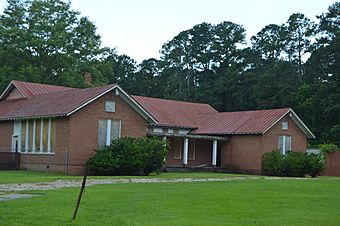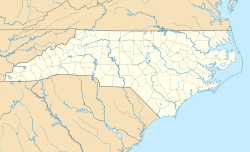Princeton Graded School facts for kids
Quick facts for kids |
|
|
Princeton Graded School
|
|

Facade
|
|
| Location | 601-611 W. Edwards St., Princeton, North Carolina |
|---|---|
| Area | 3.9 acres (1.6 ha) |
| Built | 1925-1926 |
| Architect | J.P. Rogers |
| Architectural style | Rosenwald School |
| NRHP reference No. | 05001139 |
| Added to NRHP | October 4, 2005 |
The Princeton Graded School is a special old building located in Princeton, North Carolina. It was built a long time ago, between 1925 and 1926. This school is important because it was a Rosenwald school, which were schools built for African American children during a time when schools were separated by race.
The building has a unique H-shape and is made of brick. It also has a cool porch with classic columns. Even though the school closed in 1973, it is still remembered for its history. In 2005, it was added to the National Register of Historic Places, which means it's a very important historical site.
Contents
What Was a Rosenwald School?
A Rosenwald school was a special kind of school built for African American children in the early 1900s. These schools were created with help from Julius Rosenwald, who was the head of Sears, Roebuck and Company. He worked with Booker T. Washington and the Tuskegee Institute to build thousands of schools across the Southern United States.
These schools were very important because they gave many children a chance to get an education. Before these schools, many communities did not have good places for African American children to learn. The Princeton Graded School is one example of these important schools.
The School's Design and Features
The Princeton Graded School was designed by an architect named J.P. Rogers. It was built to be a "six-teacher" school, meaning it had enough classrooms for six teachers to teach different grades. Its H-shape was a common design for schools at that time.
Over the years, a few parts were added to the school. One addition was a small brick section that held two bathrooms. Another part was added for the furnace, which kept the school warm. The original porch, with its strong columns, is still there today.
A Look at the School Grounds
The school property is about 3.9 acres, which is like having almost four football fields. Besides the main school building, there are a couple of other interesting things on the property.
There is a small cemetery nearby, which was used from about 1934 to 1961. It has less than 20 visible markers, showing where people were buried. There's also an old septic tank from around 1950, which was part of the school's plumbing system.
Becoming a Historic Place
The Princeton Graded School was officially listed on the National Register of Historic Places on October 4, 2005. This is a list of places in the United States that are important to history. When a building is on this list, it means it has special historical value and should be protected.
Being on the National Register helps people learn about the past and understand how important places like the Princeton Graded School are to our country's story. It reminds us of the efforts made to provide education for all children, even during challenging times.
References



